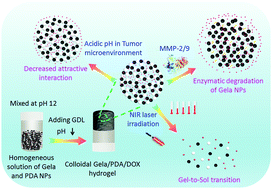Charge reversal induced colloidal hydrogel acts as a multi-stimuli responsive drug delivery platform for synergistic cancer therapy†
Abstract
Resulting from the abnormal vasculature and increased interstitial fluid pressure of tumors, the heterogeneous and insufficient distribution of drugs is likely to be responsible for the modest survival benefits of many clinical and pre-clinical medicines. In this study, unlike whole body medication by conventional adjuvant chemotherapy, an injectable and colloidal hydrogel composed of amphoteric gelatin nanoparticles (Gela NPs) and polydopamine nanoparticles (PDA NPs) was developed to realize multi-stimuli- (such as acidic pH, enzymes and near infrared light) responsive drug delivery properties and combined chemo-photothermal cancer treatment. Upon the decomposition of glucono delta-lactone, the system pH decreases below the isoelectric point of the Gela NPs, and their resulting charge reversal induces the formation of a uniform hydrogel. The optimized hydrogel, with varied composition, showed good viscoelasticity and self-healing performance, as well as excellent biocompatibility for implantation. When irradiated with near-infrared light, the DOX-loaded colloidal hydrogel exhibited a synergistic cell-killing effect, indicating its good potential for therapeutic applications.



 Please wait while we load your content...
Please wait while we load your content...